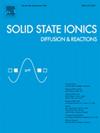In the wavenumber range 1000–2000 cm−1, weak second-order spectra have been discovered for the first time in the Raman spectra of the ferroelectric phase of ceramic solid solutions Li0.12Na0.88TayNb1-yO3 (y = 0–0.5). They correspond to bound states of fundamental polar vibrations of oxygen ions of O6 oxygen octahedra of A1- and E-type symmetry and arise only due to strong anharmonicity of vibrations. It has been shown that the effects of strong anharmonicity manifest themselves most clearly for librational vibrations of O6 oxygen octahedra as a whole. The Raman band (ν = 76 cm−1, T = 293 K) corresponds to the librational vibrations of O6 oxygen octahedra. Solid solution of the composition Li0.12Na0.88Ta0.5Nb0.5O3 is characterized by the most disordered sublattice of niobium and tantalum. The band of this ceramics composition with increasing temperature experiences a strong broadening and a decrease in intensity, compared to other bands of the spectrum; at temperatures above 650 K the band is completely blurred into the wing of the Rayleigh band. Note that all this happens in the pre-transition region of the diffuse superionic phase transition in the range ≈670-730 K. This fact indicates the dynamic disordering of the sublattice of O6 oxygen octahedra. Dynamic disordering accompanies the phase transition to the superionic state in the Li0.12Na0.88Ta0.5Nb0.5O3 solid solution; therefore, the activation energy of ionic conductivity decreases sharply. In this case, the disorder of cations in the sublattice of niobium and tantalum is the greatest precisely at y = 0.5. It facilitates the superionic phase transition. Dynamic disordering of the O6 oxygen octahedra sublattice as a whole was not detected for other compositions of Li0.12Na0.88TayNb1-yO3 solid solutions with y < 0.5 in the studied temperature range. A phase transition is observed (through some intermediate metastable state) to a state with high ionic conductivity for lithium at a relatively high value of activation energy for conductivity before and after the transition for these compositions. Thus, approaches have been developed to predict the possibility of superionic conductivity in perovskite oxygen-polyhedral structures with the general formula Li0.12Na0.88TayNb1-yO3 based on studying the concentration and temperature dependences of first- and second-order Raman spectra. The developed approaches are apparently valid for a wider range of oxygen-polyhedral structures.


